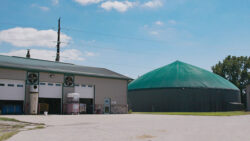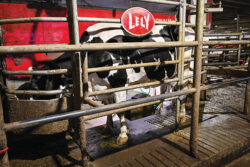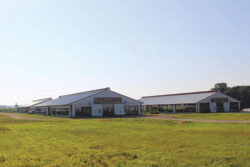
Features
Applications
Dairy
Investing ambitiously and learning for life
The Indiana-based farm has been recognized for innovation and sustainability.
February 1, 2023 by Julienne Isaacs
 An aerial view of Homestead Dairy in Plymouth, IN.
All photos courtesy of Homestead Dairy.
An aerial view of Homestead Dairy in Plymouth, IN.
All photos courtesy of Homestead Dairy. Back in 2003, Brian Houin had just completed a degree at Purdue University and returned to work at the Houin family farm, Homestead Dairy, in Plymouth, IN.
Houin “couldn’t wait to be done with college and out in the real world.”
Then came a moment when he realized that to be successful he’d need to keep studying. “The biggest irony for me was that I realized I was doing this continual learning. And that’s what we’re going to continue to do,” he says.
In 2021, Homestead Dairy was named the 2021 Innovative Dairy Farmer of the Year at the International Dairy Foods Association (IFDA) Dairy Forum. It was an important public recognition of something the Houins have always known about themselves: if it makes sense for the family and the operation, they’re willing to try something new.
The farm started in 1945 when Elmer and Lena Houin, Brian’s grandparents, bought just over 200 acres and nine dairy cows. In 1979, Brian’s father and uncle purchased the farm and christened it “Homestead Dairy.” Since then, the farm has steadily grown. These days, it’s managed by the third and fourth generations of Houins, and operates on three facilities. “We’re milking around 5,000 cows,” says Houin.
In 2013, the family installed a methane digester at their main facility. In 2015, they built three new technologically advanced calf barns. Just two years later, they installed 36 Lely Robotic Milkers at another of their facilities.
Each of these investments represents a huge amount of research, discussion, time and resources. They’ve paid off, says Houin, but only because the family has been willing to continually adapt and improve the way they do things.
“The way we managed cows 30 years ago is not how we manage cows today and it probably won’t be the way we manage cows 15 to 20 years from now,” says Houin. “Not all farms that have invested in technology have been successful. You have to be willing to learn from other people, from industry and from yourself.
“It’s not always perfect, and we’ve had hiccups along the way, but being able to diagnose problems and fix them has allowed these technologies to be successful.”
The digester difference
When the Houins decided to add the anaerobic digester to their main facility a decade ago, the equipment was still very new to the dairy community.

Methane gas collected from the digester’s tanks runs generators that supply electricity to the local grid, powering around 100 homes.
“It was difficult for the bank to be comfortable with it at first, and then it was difficult to get it insured. Insurance companies didn’t know anything about it and being that methane gas is flammable, we were paying premiums,” says Houin.
The Houins received a government grant to help build the digester, which helped, he adds.
The digester processes liquid slurry, which is housed in two tanks covered with a fabric roof, Houin explains. The liquid is maintained at about 105 degrees and bacteria breaks down the manure. Homestead Dairy also receives cafeteria food waste from nearby Notre Dame University, which is processed along with the manure. Methane gas collected from the tanks runs generators that supply electricity to the local grid, powering around 100 homes.
Manure that comes from the digester is then recycled into the farm’s cropping operation; after processing the nutrients are sufficiently broken down to be much more plant-available, he explains. “So we can reduce again the amount of nutrients we’re applying to the ground.”
Houin’s cousin Matt Houin manages the cropping operation – 5,000 acres of corn, soybeans and seed corn. The Houins use variable rate technology and soil testing to ensure they don’t apply excess nutrients.
They hope to eventually add a second digester, he says.
Investing in the future
Not all of Homestead Dairy’s equipment investments over the years have been made strictly by choice.
One example is the auto-feeding calf barns. Houin says in 2012, Indiana passed regulation that changed how the state legally views calves: prior to this, each calf technically counted as a third of an animal due to its size. A cow-calf unit, for example, would be considered 1.3 animals in terms of its resource consumption.

One of Homestead Dairy’s facilities houses 36 Lely Robotic Milkers.
Since the law changed, animals are considered complete “units” regardless of size. As a result of the change, hutch water management either had to shift, allowing for collection of rainwater around hutches to meet requirements, or calves had to be housed in barns.
The Houins opted to build group housing for their calves – two new barns with auto-feeding and calf-monitoring equipment. Initially, the idea of group housing worried Houin. Prevailing wisdom at the time suggested that calves could build better immunity by being housed individually. That was Houin’s view, too. Herd health had always been a strong emphasis at Homestead Dairy: Houin has run benchmarks on herd health for 17 years.
But after a lot of research, Houin decided to go for it. “We toured a few farms that had [built group housing], talked with experts in the industry and ventilation experts, and tried to get the right design to ensure we were successful,” he says.
“I was amazed – the calf growth and health has been a lot better in a group setting. It’s easier on employees because they’re in a barn. And tour groups absolutely love it – they can go into the pen and play with the calves and have a more intimate time with the calves compared to when they’re in hutches.”
Over four years, the Houins built a total of four calf barns. Each is equipped with auto-feeders that read individual calves’ RFID tags to customize intake based on individual animals’ dietary needs. The calves are growing faster and stronger in community housing, says Houin.
There’s no perfect system for deciding which investments are going to be profitable in the long run. All the research in the world can’t solve that question. Houin says the farm keeps a running wish list of three or four investments they’d like to make in the future. “We have only so much funds to spend, [so] you try to pick to see which is going to have the biggest impact on the operation and the business,” he says.

Houin says calf growth and health has improved in a group setting
It’s not always a matter of short-term payback. For example, Houin says there’s interest from multiple companies in installing solar panels on the farm’s land. But these contracts are active for decades, meaning “you’re making decisions that will last for multiple generations.”
“It is very difficult to think ahead and try to figure out the pros and cons and what’s the best decision for our family,” Houin says. “[About] seven years ago, we did a strategic plan and that helped guide us a little bit, and now we sit down and hash it out and try to come up with a consensus on what to do.”
Sometimes, Houin says, it can be valuable to keep an eye on what the neighbors are doing. An example is technologies that will help farms shift to carbon neutrality. Houin doesn’t believe the technology is ready yet. But the market will demand it in time.
“I know of some farms that like being the first on those things, so I’ll keep my eyes and ears open, and when they get it to where it’s working, that will be the time we look at investing in those things as well,” he says.
It’s a learning process, like everything else at Homestead Dairy. Continual education is a guiding value in every single area of the farm life. The Houins wouldn’t have it any other way. •